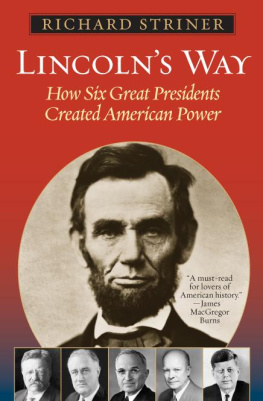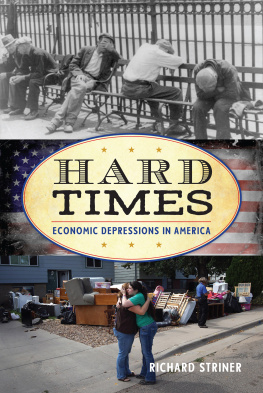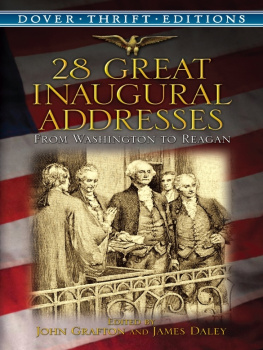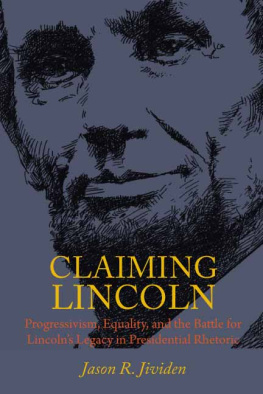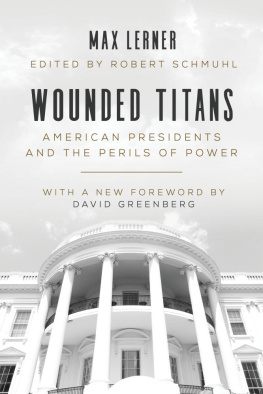Lincolns Way
Lincolns Way
How Six Great Presidents
Created American Power
Richard Striner
ROWMAN & LITTLEFIELD PUBLISHERS, INC.
Lanham Boulder New York Toronto Plymouth, UK
Published by Rowman & Littlefield Publishers, Inc.
A wholly owned subsidiary of The Rowman & Littlefield Publishing Group, Inc.
4501 Forbes Boulevard, Suite 200, Lanham, Maryland 20706
www.rowmanlittlefield.com
Estover Road, Plymouth PL6 7PY, United Kingdom
Distributed by National Book Network
Copyright 2010 by Rowman & Littlefield Publishers, Inc.
All rights reserved. No part of this book may be reproduced in any form or by any electronic or mechanical means, including information storage and retrieval systems, without written permission from the publisher, except by a reviewer who may quote passages in a review.
British Library Cataloguing in Publication Information Available
Library of Congress Cataloging-in-Publication Data
Striner, Richard, 1950
Lincolns way : how six great Presidents created American power / Richard Striner.
p. cm.
Includes bibliographical references and index.
ISBN 978-1-4422-0065-4 (cloth : alk. paper) ISBN 978-1-4422-0066-1 (electronic)
1. PresidentsUnited StatesHistory. 2. Political leadershipUnited StatesHistory. 3. Federal governmentUnited StatesHistory. 4. Power (Social sciences)United StatesHistory. 5. United StatesPolitics and government. 6. Lincoln, Abraham, 18091865Influence. I. Title.
JK511.S77 2010
973.09'9dc22 2010007265
` The paper used in this publication meets the minimum requirements of American National Standard for Information SciencesPermanence of Paper for Printed Library Materials, ANSI/NISO Z39.48-1992.
Printed in the United States of America
To my daughters generation.
ACKNOWLEDGMENTS
I wish to thank the following people for their contributions to the book. I am deeply grateful to James MacGregor Burns, James M. McPherson, Fred I. Greenstein, David A. Nichols, Richard Wayne Etulain, William D. Pederson, Joseph R. Fornieri, Adam Goodheart, Carl Reddel, Rocco C. Siciliano, Samuel C. O. Holt, Sara Gabbard, and my parents Herbert and Erma Striner for reading the manuscript in whole or in part. At Rowman & Littlefield, executive editor Niels Aaboe was a constant source of support and encouragement, and production editor Patricia Stevenson was extremely helpful. I wish to thank Wallace Dailey, curator of the Theodore Roosevelt collection at Harvard College Library, for his kind permission to use a splendid image from the collection. Special thanks to John W. Wright for his excellent suggestions. Any errors in the book are my own.
Introduction
Was Lincoln the greatest of our presidents? Many millions of Americans are fully convinced that he was, and for some excellent reasons. Lincoln was, after all, the Savior of the Union, the Great Emancipator, and a leader of remarkable character. But his greatness exceeded these achievements. For the case can be made that he took the young nation that the Founders created and positioned it for global power. He unleashed a potential in American life that would make the young republic a world colossus over time.
From the left and the right he borrowed wisdom. Then he used the vast power of our federal government in brilliant and extraordinary ways. In so doing, he created a tradition that would influence the twentieth century.
Historians, pundits, and political leaders have neglected this tradition, for its story has never been told. It is the story of an apostolic succession that moved from Lincoln to Theodore Roosevelt to Franklin Delano Roosevelt, who passed it on to Truman, Eisenhower, and Kennedy, all of whom learned from each other in sequence and developed ideassuperb ideasthat gave the world significant statecraft. Obama may add to this tradition.
This is a book about men and ideas: heroic ideas and the people who put them to use. Its a book about leaders who believed in the American promise, but they also believed that only powerful governance could make that vision a reality. They fought tooth and nail against the people who believed that the government that governs best, governs least.
They did not promote government mindlessly. They denounced the idea that more government is always the answer. But they believed that it was sometimes the answer when it came to the nations necessities. They knew the great dangers of chaos and they hoped to make Americans prepared for all kinds of surprisesand emergencies. They believed in the value of coordinated national lifein teamwork.
The presidents who followed in Lincolns path blended wisdom and power from conservative and liberal thought, while discarding what was spoiled or dogmatic. Lincoln was in some respects the first of our presidents to synthesize the principles of left and right with a measure of success. Theodore Roosevelt was eager to revive this achievement. He declared at the end of his presidency that his work as a Republican leader had been to take hold of the conservative party and turn it into what it had been under Lincoln, that is, a party of progressive conservatism, or conservative radicalism; for of course wise radicalism and wise conservatism go hand in hand. Franklin D. Roosevelt made a similar statement in the course of a 1936 campaign speech: Reform if you would preserve. I am that kind of conservative because I am that kind of liberal.
Lincolns way was adopted by the presidential Roosevelts and passed from the first to the second. Lincoln is my hero, wrote Theodore Roosevelt to a friend in 1905. In the very same year1905young Franklin Roosevelt exclaimed in a letter that everyone is talking about Cousin Theodore saying that he is the most prominent figure of present day history. From Lincoln to Theodore and Theodore to Franklin, the tradition continued to develop through World War II and beyondfrom Truman all the way to Kennedy.
Then it vanished.
I believe that three particular themes in this legacy have served the United States well: (1) a convergence of the left and the right on certain fundamental issues that unite us; (2) an expansion of Americas power to produce and consume, with an economic program to advance and accelerate the process; and (3) a conviction that the federal government can lead us in magnificent endeavors. Lincoln put all of these principles to use in his presidential years.
He used federal power in unprecedented waysnot only to preserve the American nation but also to reach down a hand to help liberate the downtrodden slaves. He supported the creation of the federal Freedmens Bureau, a welfare agency that heralded the work of FDR. Even in the midst of total warwith its vast hardshiphe supported the construction of expensive public works in the form of the transcontinental railroad. His financial method used a bold and largely successful mixture of taxes, deficit spending, and direct creation of money, the Civil War Greenbacks.
He unified the insights of left and right through the view of human nature he expressed in his fight to end slavery. He showed a grim and conservative recognition of the facts about people at their worst . The enslavement of others was for Lincoln a sign of monstrosity within the human spirit. Lincolns open acknowledgment of human evil will stand for all time as a conservative reproach against utopian schemes and the naivet that propels them. But throughout his career Lincolns social ideals bespoke a true egalitarian optimismthe quintessence of the liberal outlook.
Was this double-sided attitude of Lincolns inconsistentor paradoxical? No. Lincoln simply believed in doing justice to the best and the worst of human nature. Consequently, it is vain to try to classify Lincoln as a clear-cut conservative or liberal. He was both.

